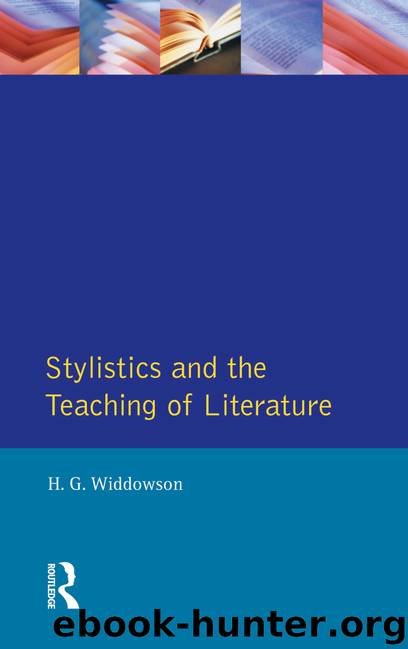Stylistics and the Teaching of Literature by Widdowson H. G

Author:Widdowson, H. G.
Language: eng
Format: epub
ISBN: 978-1-317-86953-5
Publisher: Taylor & Francis (CAM)
* I have deliberately drawn most of my illustrations from the following books on the assumption that they should be fairly easily accessible to readers wishing to follow up the points I raise and to subject the stories referred to to closer investigation: Christopher Dolley (ed.), The Penguin Book of English Short Stories’, James Cochrane (ed.), The Penguin Book of American Short Stories.
* T. S. Eliot, Four Quartets (Burnt Norton), Faber and Faber, 1959.
PART TWO
5
Literature as subject and discipline
The preceding chapters have presented an approach to the study of literature which is stylistic in the sense defined in Chapter 1 in that it attempts to characterise literary writing as discourse and so to mediate between the linguist’s treatment of literature primarily as text and the critic’s treatment of it primarily as messages. Such an approach seeks to show how the use of linguistic patterns creates a form of communication which conveys the unique reality of the individual vision. In Chapter 1 I made the claim that an approach of this kind is of particular value for the study of literature as a subject. My purpose in this and the succeeding chapter is to substantiate this claim. In the present chapter I shall try to show how the approach that has been described can indicate how the subject of literary studies might be defined and in the chapter that follows I shall discuss a number of ways in which the subject might actually be taught in the classroom. This chapter, then, is concerned with certain pedagogical principles and the next with some of the pedagogical practices which might realise them.
It might of course be objected that there is no need to define literary studies as a subject by reference to stylistics since teachers already have a clear enough idea as to what the aims and procedures of a literature course should be, even though these might not have been defined in terms of explicit principles. There are two points to be made here, I think. The first is that although individual teachers may often work out a way of teaching literature as a subject, their own experience as students and the type of examination for which they must prepare their pupils will tend to make them define literature as a subject with reference only to literature as a discipline. The teacher and examiner of literature will take his cue from the literary scholar just as the teacher and examiner of language will take his cue from the linguist, the assumption being that in each case the subject is a simplified and abridged version of the discipline to which it is most obviously related. This is not surprising since it is still generally true to say that the teacher of language and literature has no training other than what he might acquire incidentally in studying for his first degree, so that his only guide as to what and how to teach to others is what and how he was taught himself and first degree courses are (again, generally speaking) discipline-based.
Download
This site does not store any files on its server. We only index and link to content provided by other sites. Please contact the content providers to delete copyright contents if any and email us, we'll remove relevant links or contents immediately.
Still Me by Jojo Moyes(11219)
On the Yard (New York Review Books Classics) by Braly Malcolm(5512)
A Year in the Merde by Stephen Clarke(5366)
Eleanor Oliphant Is Completely Fine by Gail Honeyman(5239)
The Bookshop by Penelope Fitzgerald(3810)
How Music Works by David Byrne(3233)
Surprise Me by Kinsella Sophie(3099)
Pharaoh by Wilbur Smith(2977)
Why I Write by George Orwell(2911)
A Column of Fire by Ken Follett(2583)
Churchill by Paul Johnson(2543)
The Beach by Alex Garland(2543)
The Songlines by Bruce Chatwin(2523)
Aubrey–Maturin 02 - [1803-04] - Post Captain by Patrick O'Brian(2293)
Heartless by Mary Balogh(2243)
Elizabeth by Philippa Jones(2181)
Hitler by Ian Kershaw(2170)
Life of Elizabeth I by Alison Weir(2050)
Harry Potter and the Cursed Child by J. K. Rowling & John Tiffany & Jack Thorne(2049)
